ECO mode Citroen C4 PICASSO 2016 2.G Owner's Guide
[x] Cancel search | Manufacturer: CITROEN, Model Year: 2016, Model line: C4 PICASSO, Model: Citroen C4 PICASSO 2016 2.GPages: 527, PDF Size: 13.72 MB
Page 206 of 527
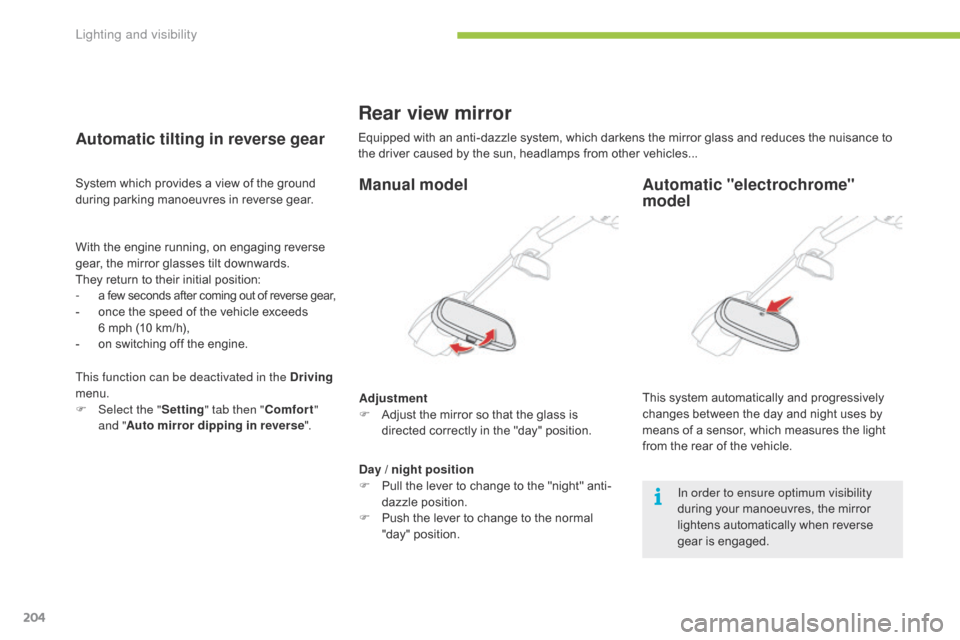
204
C4-Picasso-II_en_Chap05_eclairage-visibilite_ed01-2016
Rear view mirror
Equipped with an anti-dazzle system, which darkens the mirror glass and reduces the nuisance to the driver caused by the sun, headlamps from other vehicles...
Manual model
Adjustment
F A djust the mirror so that the glass is
d
irected correctly in the "day" position.
In order to ensure optimum visibility
during
your manoeuvres, the mirror
l
ightens automatically when reverse
g
ear
i
s
enga
ged.
Day / night position
F
P
ull the lever to change to the "night" anti-
dazzle
position.
F
P
ush the lever to change to the normal
"
day" position.
Automatic "electrochrome"
model
This system automatically and progressively changes between the day and night uses by
m
eans of a sensor, which measures the light
f
rom the rear of the vehicle.
Automatic tilting in reverse gear
With the engine running, on engaging reverse gear, the mirror glasses tilt downwards.
They
return to their initial position:
-
a few seconds a fter c oming o ut o f r everse g ear,- once the speed of the vehicle exceeds 6 m
ph (10 km/h),
-
o
n switching off the engine.
System
which provides a view of the ground
d
uring parking manoeuvres in reverse gear.
This function can be deactivated in the Driving
menu.
F
Sel
ect the " Setting" tab then " Comfort"
and " Auto mirror dipping in reverse".
Lighting and visibility
Page 210 of 527
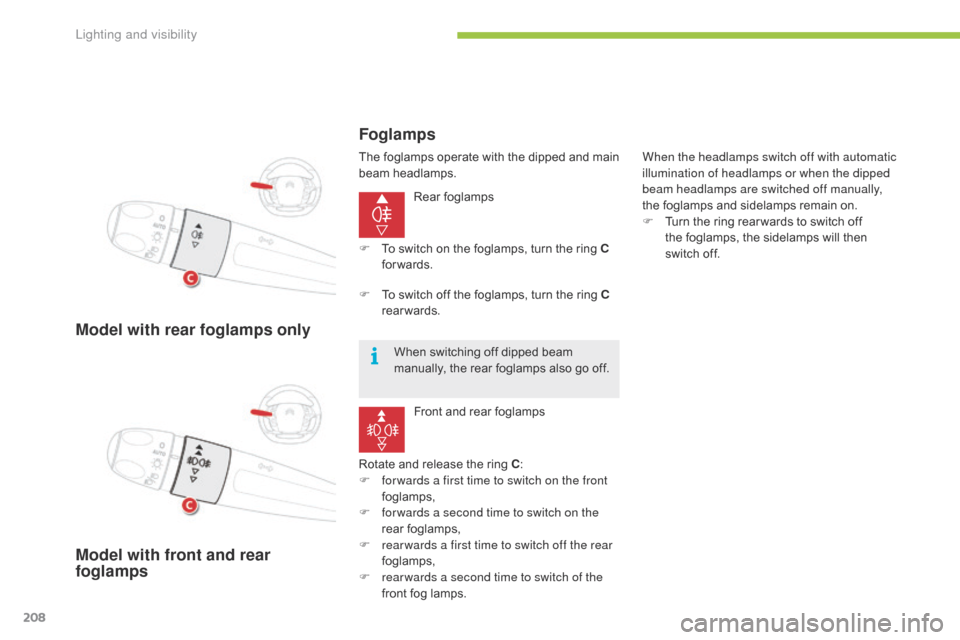
208
C4-Picasso-II_en_Chap05_eclairage-visibilite_ed01-2016
Model with rear foglamps only
Rear foglamps
Rotate
and release the ring C:
F
f
or wards a first time to switch on the front
foglamps,
F
f
or wards a second time to switch on the
rear
fo
glamps,
F
r
ear wards a first time to switch off the rear
foglamps,
F
r
ear wards a second time to switch of the
front
fog lamps.
Model with front and rear
foglamps Foglamps
F To
switch on the foglamps, turn the ring C
forwards.
Front
and rear foglamps
F
T
o switch off the foglamps, turn the ring C
rearwards. When the headlamps switch off with automatic
illumination of headlamps or when the dipped
beam headlamps are switched off manually,
the
foglamps and sidelamps remain on.
F
T
urn the ring rear wards to switch off t
he foglamps, the sidelamps will then s
witch off.
When
switching off dipped beam
m
anually, the rear foglamps also go off.
The
foglamps operate with the dipped and main
b
eam
h
eadlamps.
Lighting and visibility
Page 211 of 527
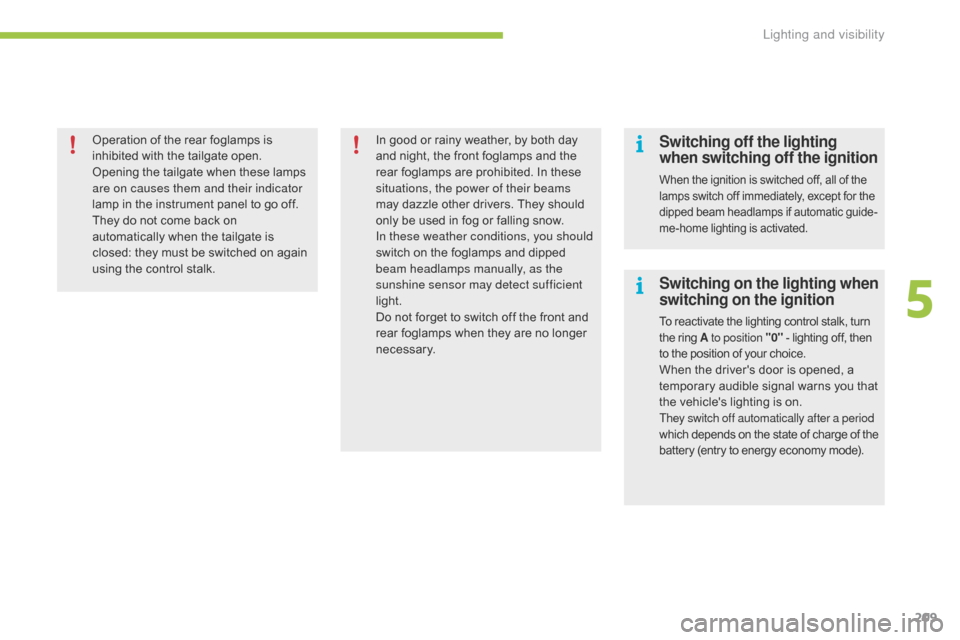
209
C4-Picasso-II_en_Chap05_eclairage-visibilite_ed01-2016
Operation of the rear foglamps is inhibited with the tailgate open.
Opening
the tailgate when these lamps
a
re on causes them and their indicator
lamp
in the instrument panel to go off.
They
do not come back on
a
utomatically when the tailgate is
c
losed: they must be switched on again
u
sing the control stalk. In
good or rainy weather, by both day a
nd night, the front foglamps and the
r
ear foglamps are prohibited. In these
s
ituations, the power of their beams
may
dazzle other drivers. They should
o
nly be used in fog or falling snow.
In these weather conditions, you should
switch
on the foglamps and dipped
b
eam headlamps manually, as the
sunshine sensor may detect sufficient
light.
Do
not forget to switch off the front and
r
ear foglamps when they are no longer
n
ecessary.Switching off the lighting
when switching off the ignition
When the ignition is switched off, all of the lamps switch off immediately, except for the d
ipped beam headlamps if automatic guide-
me-home
lighting is activated.
Switching on the lighting when
switching on the ignition
To reactivate the lighting control stalk, turn the ring A to position "0"
- lighting off, then t
o the position of your choice.
When the driver's door is opened, a temporary audible signal warns you that
t
he vehicle's lighting is on.
They switch off automatically after a period
which depends on the state of charge of the b
attery (entry to energy economy mode).
5
Lighting and visibility
Page 228 of 527
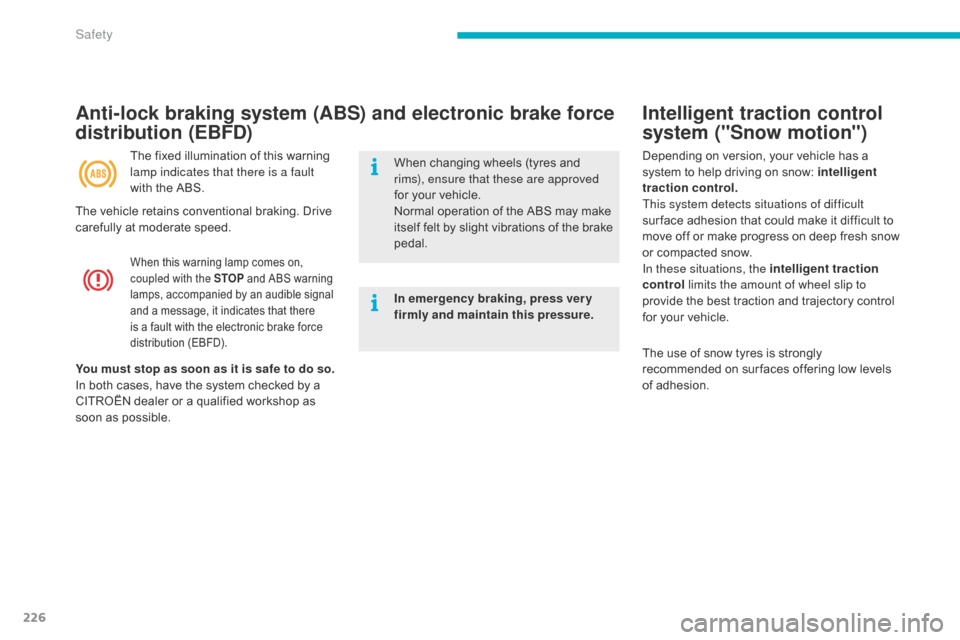
226
C4-Picasso-II_en_Chap06_securite_ed01-2016
Intelligent traction control
system ("Snow motion")
When this warning lamp comes on, coupled with the STOP and ABS warning
l
amps, accompanied by an audible signal
a
nd a message, it indicates that there
i
s a fault with the electronic brake force
di
stribution
(
EBFD).
Anti-lock braking system (ABS) and electronic brake force
distribution (EBFD)
The fixed illumination of this warning lamp indicates that there is a fault
with
the ABS. Depending
on version, your vehicle has a s
ystem to help driving on snow: intelligent
traction control.
This system detects situations of difficult
sur face
adhesion that could make it difficult to
m
ove off or make progress on deep fresh snow
o
r compacted snow.
In these situations, the intelligent traction
control limits the amount of wheel slip to
provide
the best traction and trajectory control
f
or your vehicle.
The
use of snow tyres is strongly
r
ecommended on sur faces offering low levels
o
f adhesion.
When
changing wheels (tyres and
r
ims), ensure that these are approved
for
your vehicle.
Normal
operation of the ABS may make
i
tself felt by slight vibrations of the brake
ped
al.
In emergency braking, press ver y
firmly and maintain this pressure.
You must stop as soon as it is safe to do so.
In
both
cases, have the system checked by a
C
ITROËN dealer or a qualified workshop as
s
oon
as
possible.
The
vehicle retains conventional braking. Drive
c
arefully
at moderate speed.
Safety
Page 262 of 527
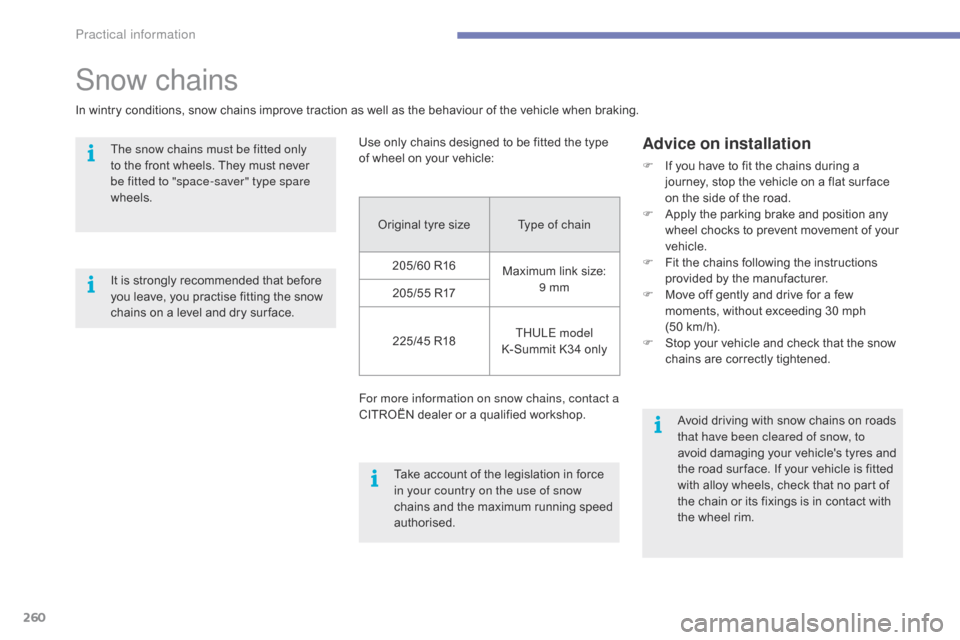
260
C4-Picasso-II_en_Chap07_info-pratiques_ed01-2016
Original tyre sizeT ype of chain
205/60 R16 Maximum
link size:
9 m
m
205/55
R17
225/45
R18 THULE model
K-Summit
K34 only
For more information on snow chains, contact a
CITROËN
dealer or a qualified workshop.
Use
only chains designed to be fitted the type
o
f
wheel on your vehicle:
Snow chains
In wintry conditions, snow chains improve traction as well as the behaviour of the vehicle when braking.
T he snow chains must be fitted only
to
the front wheels. They must never
b
e fitted to "space-saver" type spare
wheels.
Advice on installation
F If you have to fit the chains during a j
ourney, stop the vehicle on a flat sur face
o
n the side of the road.
F
A
pply the parking brake and position any
w
heel chocks to prevent movement of your
v
ehicle.
F
F
it the chains following the instructions
p
rovided by the manufacturer.
F
M
ove off gently and drive for a few
m
oments, without exceeding 30 mph
(
50 km/h).
F
S
top your vehicle and check that the snow
c
hains are correctly tightened.
Take
account
of
the
legislation
in
force
i
n your country on the use of snow
chains
and
the
maximum
running
speed
a
uthorised. Avoid
driving with snow chains on roads
t
hat have been cleared of snow, to
avoid
damaging your vehicle's tyres and
t
he road sur face. If your vehicle is fitted
w
ith alloy wheels, check that no part of
t
he chain or its fixings is in contact with
t
he wheel rim.
It
is
strongly
recommended
that
before
y
ou
leave,
you
practise
fitting
the
snow
c
hains
on
a
level
and
dry
sur face.
Practical information
Page 267 of 527
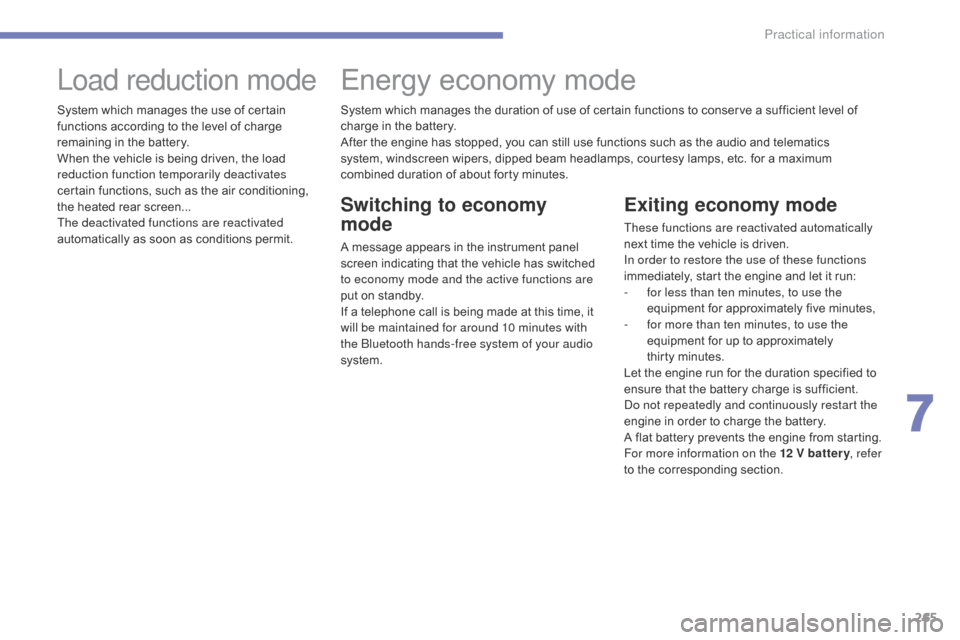
265
C4-Picasso-II_en_Chap07_info-pratiques_ed01-2016
Exiting economy mode
These functions are reactivated automatically
next time the vehicle is driven.
In order to restore the use of these functions
immediately,
start the engine and let it run:
-
f
or less than ten minutes, to use the
equipment
for approximately five minutes,
-
f
or more than ten minutes, to use the
equipment
for up to approximately
t
hirty minutes.
Let
the engine run for the duration specified to
e
nsure that the battery charge is sufficient.
Do not repeatedly and continuously restart the
engine
in order to charge the battery.
A
flat battery prevents the engine from starting.
For more information on the 12 V batter y , refer
to
the corresponding section.
Load reduction mode
System which manages the use of certain functions according to the level of charge
r
emaining in the battery.
When
the vehicle is being driven, the load
r
eduction function temporarily deactivates
certain
functions, such as the air conditioning,
t
he heated rear screen...
The deactivated functions are reactivated
automatically
as soon as conditions permit.
Energy economy mode
Switching to economy
mode
A message appears in the instrument panel s
creen indicating that the vehicle has switched
t
o economy mode and the active functions are
put
on standby.
If
a telephone call is being made at this time, it
w
ill be maintained for around 10 minutes with
the Bluetooth hands-free system of your audio
system. System which manages the duration of use of certain functions to conserve a sufficient level of
c
harge in the battery.
After the engine has stopped, you can still use functions such as the audio and telematics
s
ystem, windscreen wipers, dipped beam headlamps, courtesy lamps, etc. for a maximum
c
ombined duration of about forty minutes.
7
Practical information
Page 273 of 527

271
C4-Picasso-II_en_Chap07_info-pratiques_ed01-2016
Bonnet
F Open the left hand front door.
F
L
ift the safety catch and raise the bonnet.F
U nclip the stay from its housing and place i
t in the support slot to hold the bonnet
open.
Opening
F Pull the release lever, located at the bottom of the door aperture, towards you. Before
doing anything under the
b
onnet, switch off the Stop & Start
system
to avoid any risk of injury
r
esulting from an automatic change to
S
TART mode.
The cooling fan may star t after switching off the engine: take care with ar ticles and
clothing that might be caught by the fan blades. Do not open the bonnet under very
windy
c
onditions.
The location of the interior bonnet
release lever prevents opening of the
b
onnet when the left hand front door
is shut.
When the engine is hot, handle the
e
xterior safety catch and the stay with
c
are (risk of burns), using the protected
a
rea.
When the bonnet is open, take care not
t
o damage the safety catch.
Because of the presence of electrical equipment under the bonnet, it is recommended that
exposure to water (rain, washing, ...) be limited.
Closing
F Take the stay out of its support slot.
F C lip the stay back into its housing.
F
L
ower the bonnet and release it at the end
of
its travel.
F
P
ull on the bonnet to check that it has
l
atched correctly.
7
Practical information
Page 304 of 527
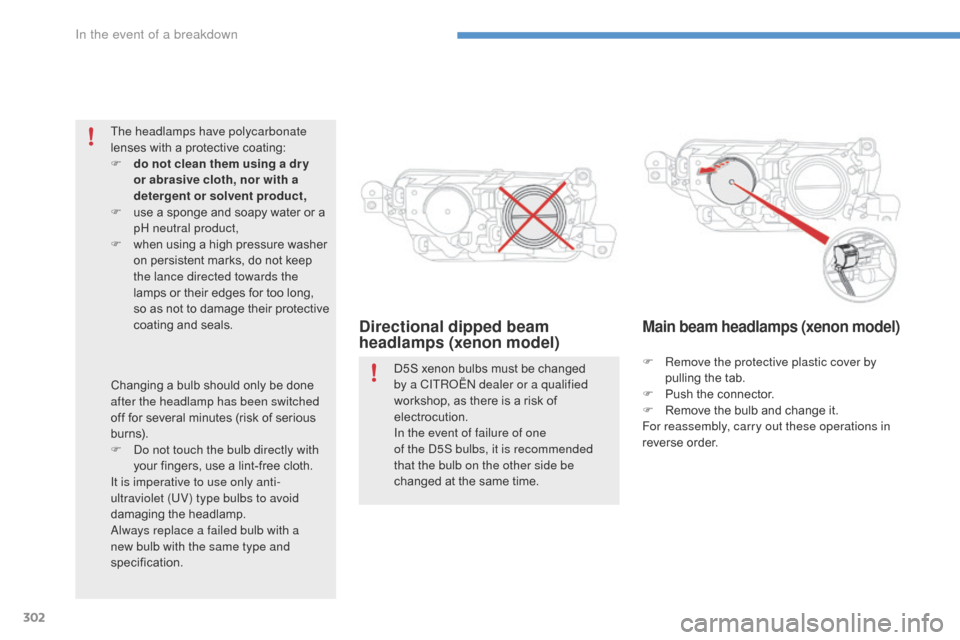
302
C4-Picasso-II_en_Chap08_en-cas-panne_ed01-2016
Directional dipped beam
headlamps (xenon model)Main beam headlamps (xenon model)
F Remove the protective plastic cover by pulling the tab.
F
P
ush the connector.
F
R
emove the bulb and change it.
For reassembly, carry out these operations in
reverse
o
rder.
D5S
xenon
bulbs
must
be
changed
b
y a CITROËN dealer or a qualified
workshop,
as
there
is
a
risk
of
el
ectrocution.
In the event of failure of one
of the D5S bulbs, it is recommended
that the bulb on the other side be
changed
at
the
same
time.
The headlamps have polycarbonate
lenses
with
a
protective
coating:
F
d
o not clean them using a dr y
or abrasive cloth, nor with a
detergent or solvent product,
F
u
se
a
sponge
and
soapy
water
or
a
p
H neutral product,
F
w
hen
using
a
high
pressure
washer
o
n
persistent
marks,
do
not
keep
t
he lance directed towards the
lamps
or
their
edges
for
too
long,
s
o
as
not
to
damage
their
protective
c
oating
a
nd
sea
ls.
Changing
a
bulb
should
only
be
done
a
fter the headlamp has been switched
off
for
several
minutes
(risk
of
serious
b
urns).
F
D
o not touch the bulb directly with
your
fingers,
use
a
lint-free
cloth.
It is imperative to use only anti-
ultraviolet (UV) type bulbs to avoid
damaging
t
he
h
eadlamp.
Always replace a failed bulb with a
new bulb with the same type and
specification.
In the event of a breakdown
Page 326 of 527
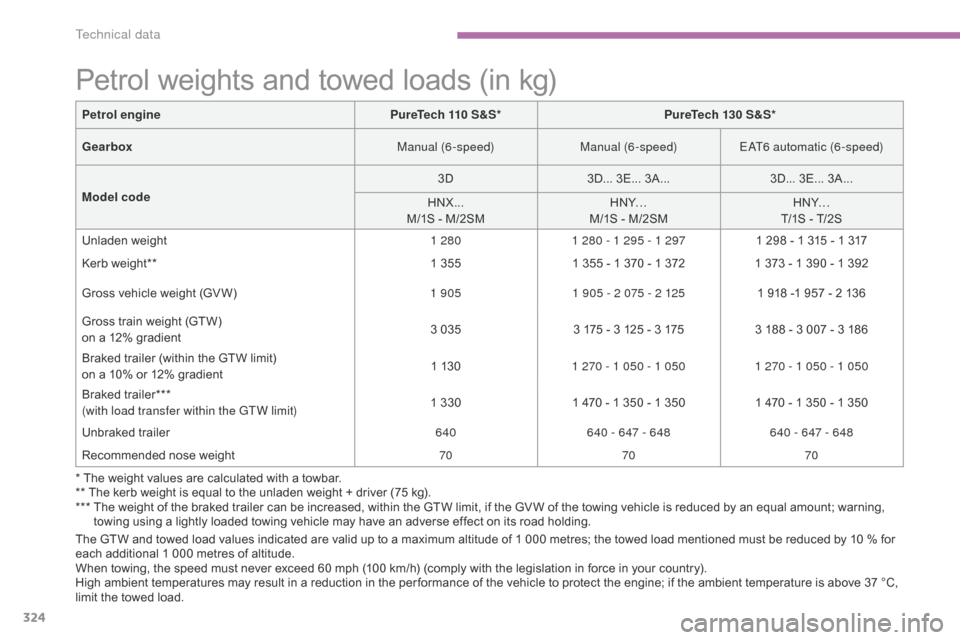
324
C4-Picasso-II_en_Chap09_caracteristiques-techniques_ed01-2016
* The weight values are calculated with a towbar.
* * The kerb weight is equal to the unladen weight + driver (75 kg).
***
T
he weight of the braked trailer can be increased, within the GTW limit, if the GV W of the towing vehicle is reduced by an equal amount; warning,
t
owing using a lightly loaded towing vehicle may have an adverse effect on its road holding.
Petrol engine
PureTech 110 S&S*PureTech 130 S&S*
Gearbox Manual (6-speed)Manual (6-speed)EAT6 automatic (6-speed)
Model code 3D
3D...
3
E...
3
A...
3D...
3
E...
3
A...
HNX...
M/1S - M/2SM
HNY…
M/1S - M/2SM
HNY…
T/1S - T/2S
Unladen weight
1 2801 280 - 1 295 - 1 297 1 298 - 1 315 - 1 317
Kerb weight**
1 355
1 355 - 1 370 - 1 372
1 373 - 1 390 - 1 392
Gross vehicle weight (GV W)
1 9051 905 - 2 075 - 2 125 1 918 -1 957 - 2 136
Gross train weight (GTW)
o
n a 12% gradient
3 035
3 175 - 3 125 - 3 175
3 188 - 3 007 - 3 186
Braked trailer (within the GTW limit)
o
n a 10% or 12% gradient
1 130
1 270 - 1 050 - 1 050 1 270 - 1 050 - 1 050
Braked trailer***
(with load transfer within the GTW limit) 1 330
1 470 - 1 350 - 1 350
1 470 - 1 350 - 1 350
Unbraked
t
railer
640640 - 647 - 648 640 - 647 - 648
Recommended nose weight
707070
Petrol weights and towed loads (in kg)
The GTW and towed load values indicated are valid up to a maximum altitude of 1 000 metres; the towed load mentioned must be reduced by 10 % for e
ach additional 1 000 metres of altitude.
When
towing, the speed must never exceed 60 mph (100 km/h) (comply with the legislation in force in your country).
High
ambient temperatures may result in a reduction in the per formance of the vehicle to protect the engine; if the ambient temperature is above 37 °C,
l
imit the towed load.
Technical data
Page 327 of 527
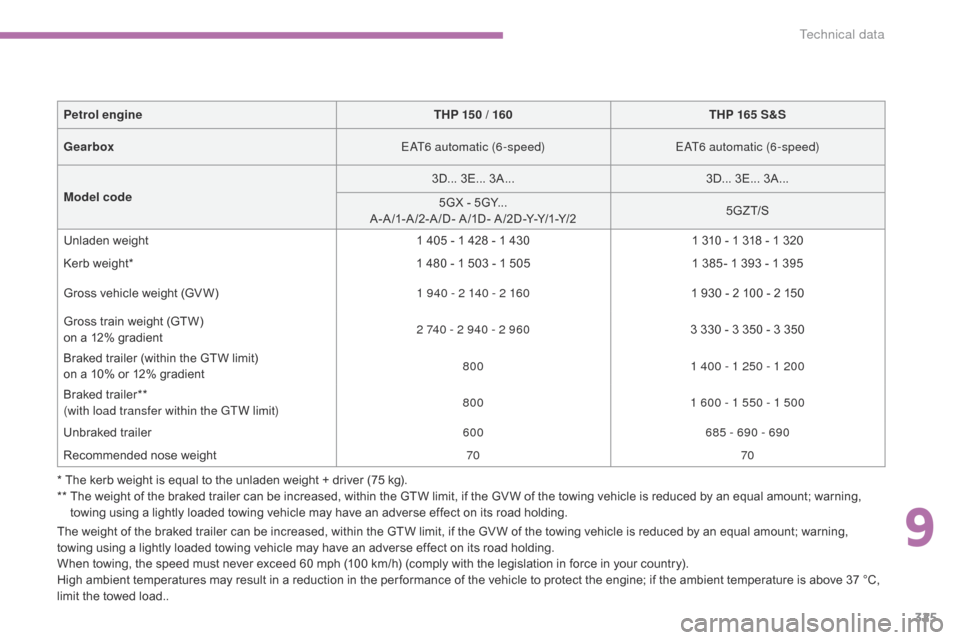
325
C4-Picasso-II_en_Chap09_caracteristiques-techniques_ed01-2016
The weight of the braked trailer can be increased, within the GTW limit, if the GV W of the towing vehicle is reduced by an equal amount; warning, towing using a lightly loaded towing vehicle may have an adverse effect on its road holding.
When
towing, the speed must never exceed 60 mph (100 km/h) (comply with the legislation in force in your country).
High
ambient temperatures may result in a reduction in the per formance of the vehicle to protect the engine; if the ambient temperature is above 37 °C,
l
imit the towed load..
Petrol engine
THP 150 / 160THP 165 S&S
Gearbox EAT6 automatic (6-speed)EAT6 automatic (6-speed)
Model code 3D...
3
E...
3
A...
3D...
3
E...
3
A...
5GX - 5GY...
A-A/1-A/2-A/D-
A/
1D-
A/
2D-Y-Y/1-Y/2
5G Z T/S
Unladen weight
1 405 - 1 428 - 1 430
1 310 - 1 318 - 1 320
Kerb weight*
1 480 - 1 503 - 1 505
1 385 - 1 393 - 1 395
Gross vehicle weight (GV W)
1 940 - 2 140 - 2 160 1 930 - 2 100 - 2 150
Gross train weight (GTW)
o
n a 12% gradient
2 740 - 2 940 - 2 960
3 330 - 3 350 - 3 350
Braked trailer (within the GTW limit)
o
n a 10% or 12% gradient
800
1 400 - 1 250 - 1 200
Braked trailer**
(with load transfer within the GTW limit) 800
1 600 - 1 550 - 1 500
Unbraked
t
railer
600685 - 690 - 690
Recommended nose weight
7070
* The kerb weight is equal to the unladen weight + driver (75 kg).
**
T
he weight of the braked trailer can be increased, within the GTW limit, if the GV W of the towing vehicle is reduced by an equal amount; warning,
t
owing using a lightly loaded towing vehicle may have an adverse effect on its road holding.
9
Technical data